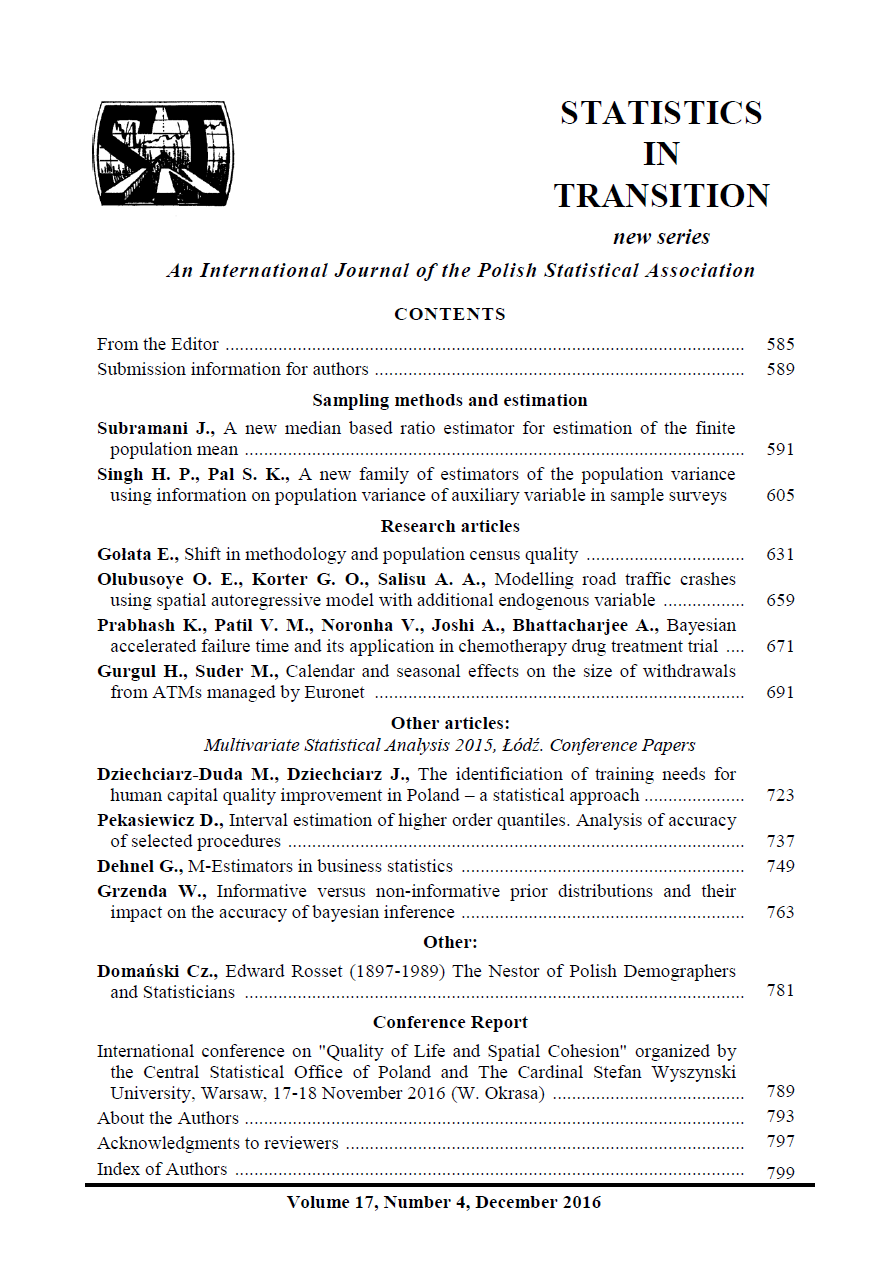ARTICLE
ABSTRACT
Road traffic crashes have become a global issue of concern because of the number of deaths and injuries. The model of interest is a linear cross sectional Spatial Autoregressive (SAR) model with additional endogenous variables, exogenous variables and SAR disturbances. The focus is on RTC in Oyo state, Nigeria. The number of RTC in each LGA of the state is the dependent variable. A 33×33 weights matrix; travel density; land area and major road length of each LGA were used as exogenous variables and population was the IV. The objective is to determine the hotspots and examine whether the number of RTC cases in a given LGA is affected by the number of RTC cases of neighbouring LGAs and an instrumental variable. The hotspots include Oluyole, Ido, Akinyele, Egbeda, Atiba, Oyo East, and Ogbomosho South LGAs. The study concludes that the number of RTC in a given LGA is affected by the number of RTC in contiguous LGAs. The policy implication is that road safety and security measures must be administered simultaneously to LGAs with high concentration of RTC and their neighbours to achieve significant remedial effect.
KEYWORDS
road traffic crashes, generalized spatial two-stage least squares estimator, instrumental-variable estimation, spillover effects.
REFERENCES
ADERAMO, A. J., (2012). Spatial pattern of road traffic accident casualties in Nigeria. Mediterranean Journal of Social Sciences, 3 (2), pp. 61–72.
CHANDRAN, A., KAHN, G., SOUSA, T., PECHANSKY, F., BISHAI, D. M., GYDER, A. A., (2013). Impact of road traffic deaths on expected years of life lost and reduction in life expectancy in Brazil. Demography, 50(1), pp. 229–36.
CIRERA, E., PLASENCIA, A., FERRANDO, J., SEGUÍ-GÓMEZ, M., (2001). Factors associated with severity and hospital admission of motor-vehicle injury cases in a Southern European Urban Area. European Journal of Epidemiology, 17 (3), pp. 201–08.
DRUKKER, D. M., PRUCHA, I. R., RACIBORSKI, R., (2013). A command for estimating spatial-autoregressive models with spatial-autoregressive disturbances and additional endogenous variables. Stata Journal, 13, pp. 287–301.
FEDERAL ROAD SAFETY CORPS (FRSC), Federal Republic of Nigeria. (2012 RTC Report). RS11.3 Oyo Sector Command.
GUERTS, K., THOMAS, I., WETS, G., (2005). Understanding spatial concentrations of road accidents using frequent item sets. Accidents analysis and prevention, 37, pp. 787–99.
HARWOOD, K., MUMFORD, C., EGLESE, R., (2013). Investigating the use of metaheuristics for solving single vehicle routing problems with time varying traversal costs. The Journal of the Operational Research Society, 64 (1), pp. 34–47.
KELEJIAN, H. H., PRUCHA, I. R., (2010). Specification and estimation of spatial autoregressive models with autoregressive and heteroskedastic disturbances. Journal of Econometrics, 157, pp. 53–67.
KELLE, P., SCHNEIDER, H., RASCHKE, C., SHIRAZI, H., (2013). Highway improvement project selection by joint consideration of cost benefit and risk criteria. The Journal of the Operational Research Society, 64 (3), pp. 313–25.
KI-MOON, B. (2012). Improving global road safety. [pdf] Roadsafe. Available at:
LABINJO, M., JUILLARD, C., KOBUSINGYE, O. C., HYDER, A. A., (2009).The burden of road traffic injuries in Nigeria: results of a population based survey. Injury Prevention, 15 (3), p.157–62.
LEVEQUE, A., HUMBLET, P. C., LAGASSE, R., (2001). Premature avoidable deaths by road traffic injuries in Belgium: Trends and geographical disparities. European Journal of Epidemiology, 17 (9), pp. 841–45.
NATIONAL BUREAU OF STATISTICS, (2007). Social statistics in Nigeria. [pdf] Federal Republic of Nigeria. Available at:
OGBODO, D., NDUOMA, E., (2011). FRSC: Nigerian roads second worst in the world. [pdf] Thisdaylive.Available at: < http://www.thisdaylive.com/articles/frsc-nigerian-roads second-worst-in-the-world/103012/> [Accessed 17 March 2013].
RANCOURT, M., CORDEAU, J., LAPORTE, G., (2013). Long-Haul Vehicle routing and scheduling with working hour rules. Transportation Science, 47 (1), pp. 81–107.
SUKHAI, A., JONES, A. P., LOVE, B. S., HAYNES, R., (2011). Temporal variations in road traffic fatalities in South Africa. Accident Analysis and Prevention, 43, pp. 421–28.
WORLD HEALTH ORGANIZATION, (2004). World report on road traffic injury prevention. Summary World Health Organization. [pdf] World Health Organization. Available at:
